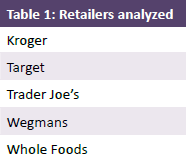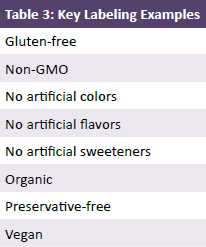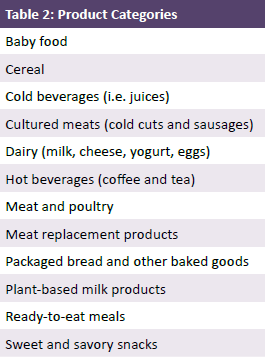Clean Label in Food & Beverages: Perception vs. Reality
Base Year: 2019
Published May 2020
Regional Coverage: United States
An increasing number of consumers opt for food and beverage products that they perceive to be “clean” or “natural.” Gluten-free, non-GMO, no artificial colors, organic, grass-fed, and preservative-free are claims consumers pay attention to in their quest for cleaner, greener living. However, what does “clean” mean to consumers? And what labeling do they look at when perusing products? This report will focus on providing a value chain analysis of the clean label food and beverages that includes a market overview, consumer perception survey, retailer initiatives, category offerings and ingredient analysis.
This Report Will Help Subscribers Address the Following Questions:
- What are the key trends and developments in “clean” food and beverage products?
- What is the consumer perception of “clean” products?
- What labeling is most appealing to consumers in different product categories?
- How clean are the products that claim the exclusion of specific ingredients?
- What initiatives are key retailers taking to attract consumers looking for “clean” products?
- What are the market opportunities throughout the value chain, from ingredients to consumers?
Report Contents
Introduction
Market Overview
- Market analysis and segmentation
- Key trends and developments
- Value chain analysis
- Future outlook
Consumer Perception Survey
Consumer perceptions and definitions of clean label and associated concepts such as organic and
GMO-free
- Importance of buying “clean” and “natural” food and beverage products
- Overall level of trust in “natural” or “clean” labels
- Perception of “clean” and what it means to consumers
- Purchases of “natural,” organic, or “clean” within categories in Table 1
- Brand awareness
- “Clean” label importance to overall category (categories highlighted in Table 1)
Retailer Initiatives
Key initiatives by select retailers
- Standards and requirements
- Offerings
- Private-label offerings
Category Offerings
For key categories listed in Table 1, the following information will be provided:
- Clean label importance to overall category
- Labels and claims
− Key and rising claims (see Table 3)
− Commonly omitted ingredients
− Promoted end benefits
− Sourcing and sustainability
Ingredient Analysis
- Analysis of ingredients used within categories
- Rating of key ingredients and their clean label/organic/GMO-free alternatives
- Brand offerings and ratings



Scope & Benefits
Clean Label in Food and Beverages: Perception vs. Reality Report will be an analysis of the
market for products that are perceived as “clean” or “natural” in the United States. The report
will analyze how important “clean” and “natural” is for consumers and their perception of what
“clean” and “natural” is in the food and beverages category. The categories covered are:
- Baby food
- Cereal
- Cold beverages (juices)
- Cultured meats (cold cuts and sausages)
- Dairy (milk, cheese, yoghurt, eggs)
- Hot beverages (coffee and tea)
- Meat and poultry
- Meat replacement products
- Packaged bread and other baked goods
- Plant-based milk products
- Ready-to-eat meals
- Sweet and savory snacks
This report will help identify business opportunities by analyzing the dynamics of the market. It
will also:
- Provide an understanding of the market and the growing movement in food and beverages
toward “clean” - Offer an understanding of the consumer and the perception of what “clean” means
- Rate key suppliers of “clean” and natural products in the market based on the ingredient list
- Evaluate retailer initiatives toward more sustainable products
- Assess market opportunities throughout the value chain, from ingredients to consumers
OTHER FOOD AND NUTRITION REPORTS
-
Beauty Nutrition: U.S. Market Brief
-
Food Indies: Analysis of Booming Independent Food and Beverage Companies
-
Plant-Based Meat: Processing Alternatives and Ingredients Assessment
-
Nutritional Supplements Market in the United States
-
Active Ingredients in Nutraceuticals: Market Analysis and Opportunities

